Wheat Kernel Damage
Principal wheat Kernel Damage
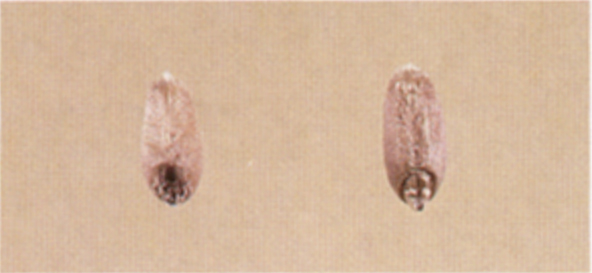
GERM DAMAGE (Sick)
Kernels which are damaged as a result of heat but are not materially discolored shall
be considered damaged.
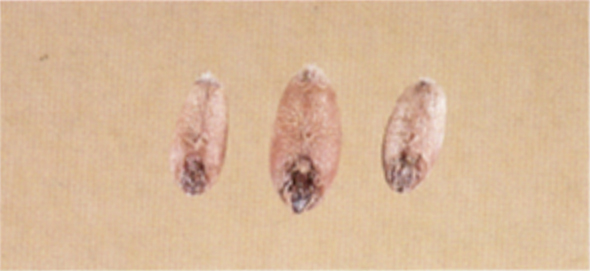
GERM DAMAGE (Mold)
Kernels which have mold in the germ shall be considered damaged. Note: The bran coat
covering the germ should be removed carefully; scraping the bran coat too deep could
remove the mold.
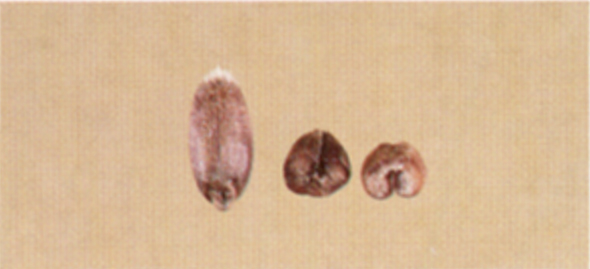
HEAT DAMAGE
Kernels which are materially discolored and damaged by heat shall be considered damaged.
It is necessary in most cases to cut the kernels to determine if the color of the
cross-section is reddish-brown, mahogany, or creamy.
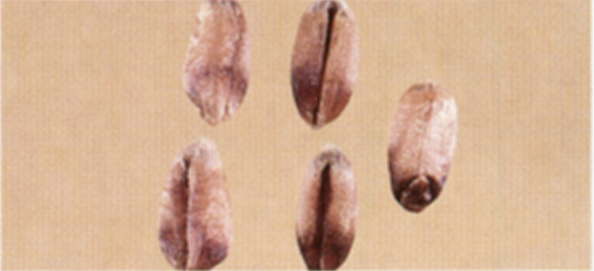
BLACK TIP FUNGUS
Kernels which are affected by Black Tip Fungus to the extent that the fungus growth
is on the germ and extends into the crease of the kernel shall be considered damaged.
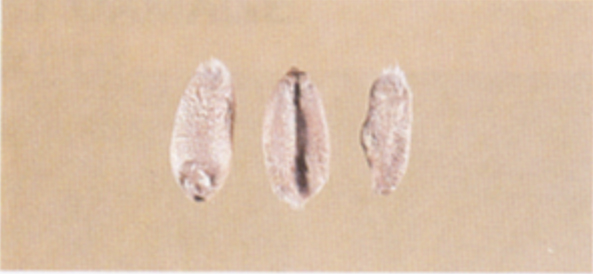
BLIGHT OR SCAB
Kernels which have a dull, lifeless, and chalky appearance as a result of disease
shall be considered damaged. The germ and crease may also have a moldy appearance.
Kernels which are not damaged enough to function as scab damage should be examined
further for moldy germs and creases.
Green Damage (immature)
Kernels which are green (immature) in color shall be considered damaged. The green color must be intense and without any yellow appearance.
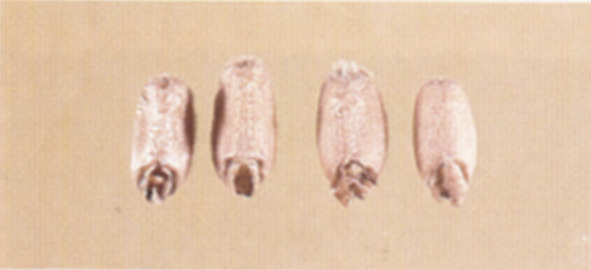
SPROUT DAMAGE
Kernels which have the germ end broken open from germination and show sprout, or from
which the sprouts have been broken off, shall be considered damaged.
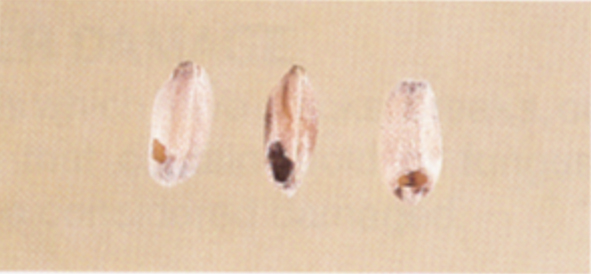
INSECT DAMAGE
Kernels which have been bored or tunneled by insects shall be considered damaged.
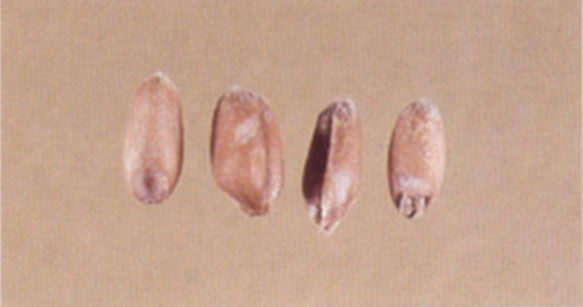
INSECT CHEWED (NOT DAMAGED)
Kernels which have been chewed by insects or rodents but are entirely free from refuse,
webbing, insects, or other types of damage shall be considered sound kernels.
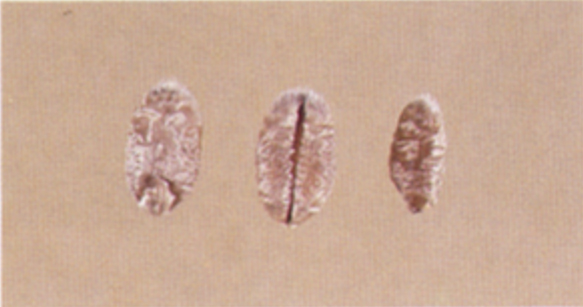
FROST DAMAGE (BLISTERED)
Kernels which have distinct frost blisters extending around the back of the kernel
and into the crease shall be considered damaged.
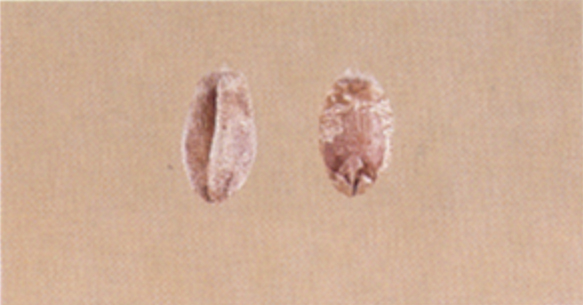
FROST DAMAGE (CANDIED)
Kernels which have a distinctly wax-like or candied appearance shall be considered
damaged. Frost-damaged (candied) kernels can be greenish, greenish-yellow, brownish,
or blackish in color. They frequently have dark stripes showing through the sides
of the kernels.
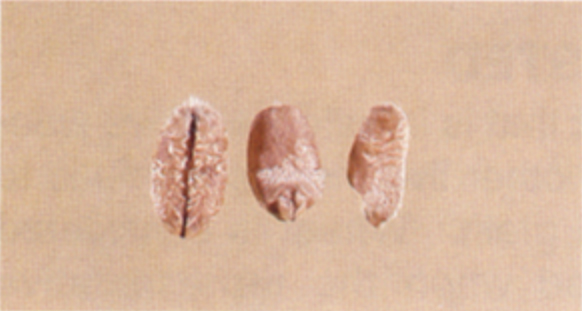
FROST DAMAGE (FLAKED)
Kernels which have a slightly flaked-off bran coat due to frost shall be considered
damaged. Evidence of frost must be present. Do not confuse flaked by frost with kernels
which have had the bran coat rubbed off because of handling.
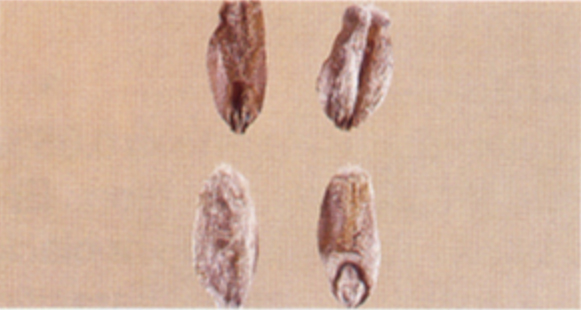
FROST DAMAGE (DISCOLORED BLACK OR BROWN)
Kernels which are discolored black or brown and have a bleached or blistered appearance
with dark lines showing through both sides shall be considered damaged. Also kernels
which are completely discolored black or brown shall be considered damaged.
Mold-Like Substance
Whole kernels of wheat which are 50 percent or more covered and pieces of kernels which are discolored and covered with a mold-like substance shall be considered damaged.
Other Damage
Kernels which have cracks, breaks, or chews that contain mold or fungus shall be considered damaged.
Special Grades
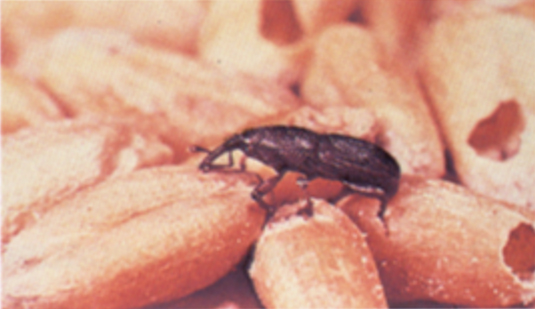
INFESTED
Wheat that is infested with live weevils or other live insects injurious to stored
grain. Wheat is considered infested when the representative sample, or lot as a whole
(stationary) or component sample (continuous loading/unloading of shiplots and bargelots),
contains two or more live insects injurious to stored grain.
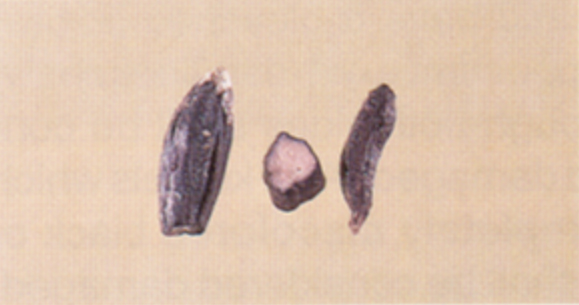
ERGOTY
Wheat that contains more than 0.05% of ergot in a 1,000-gram portion. Ergot is a hard,
reddish-brown or black grain-like mass of certain parasitic fungi that develops on
an infected wheat plant in place of the wheat kernel.
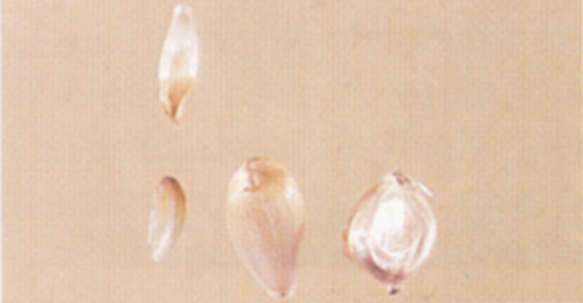
GARLICKY
Wheat that contains in a 1,000-gram portion more than 2 green garlic bulblets or an
equivalent quantity of dry or partly dry bulblets.
Light Smutty
Wheat that has an unmistakable odor of smut, or which contains in a 250-gram portion, smut balls, portions of smut balls, or spores of smut in excess of a quantity equal to 5 smut balls, but not in excess of a quantity equal to 30 smut balls of average size.
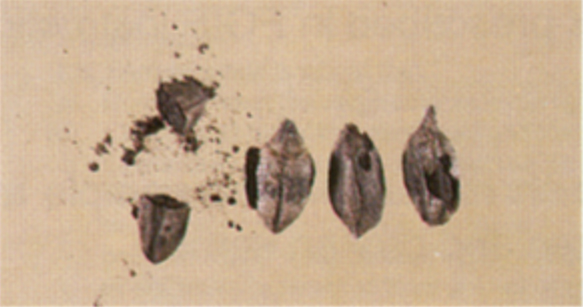
SMUTTY
Wheat which contains in a 250-gram portion smut balls, portions of smut balls, or
spores of smut in excess of a quantity equal to 30 smut balls of average size.
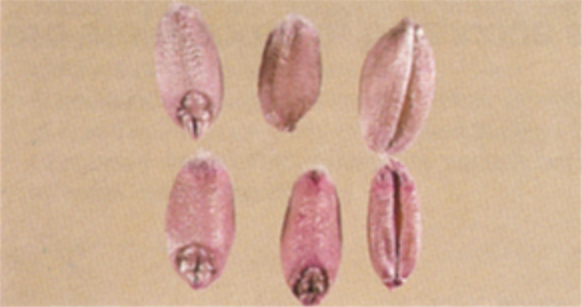
TREATED
Wheat which has been scoured, limed, washed, sulfered, or treated in such a manner
that the true quality is not reflected by either the numerical grades or the U.S.
Sample Grade designation alone.
Other grading factors
Dockage
All matter other than wheat that can be removed from the original sample by use of an approved device according to procedures prescribed in FGIS instructions. Also, underdeveloped, shriveled, and small pieces of wheat kernels removed in properly separating the material other than wheat and that cannot be recovered by rescreening or recleaning.
Shrunken and Broken Kernels
All matter that passes through a 0.065 X 3/8 oblong-hole sieve after sieving according to procedures prescribed in FGIS instructions.
Foreign Material
All matter other than wheat which remains in the sample after the removal of dockage and shrunken and broken kernels.
Test Weight per Bushel
The weight per winchester bushel (2,150.42 cubic inches) as determined using an approved device according to procedures prescribed in FGIS instructions.
Table 1A. Grade Requirements for Wheat
| Minimum limits of | |||||
|---|---|---|---|---|---|
| classes4 | Test weight per bushel | Damaged kernels | |||
| Grade | Hard Red Spring Wheat or White Clube wheat1 (pounds) |
All other classes & subclasses (pounds) | Heat damaged kernels (%) | Total2 (%) | |
| U.S. No. 1 U.S. No. 2 U.S. No. 3 U.S. No. 4 U.S. No. 5 |
58.0 57.0 55.0 53.0 50.0 |
60.0 58.0 56.0 54.0 51.0 |
0.2 0.2 0.5 1.0 3.0 |
2.0 4.0 7.0 10.0 15.0 |
|
Table 1B. Grade Requirements for Wheat
| Maximum limits of | |||||
|---|---|---|---|---|---|
| Wheat of others | |||||
| Foreign material (%) | Shrunken and broken kernels (%) | Defects3 (%) | Contrasting classes (%) | Total (%) | |
| 0.4 0.7 1.3 3.0 5.0 |
3.0 5.0 8.0 12.0 20.0 |
3.0 5.0 8.0 12.0 20.0 |
1.0 2.0 3.0 10.0 10.0 |
3.0 5.0 10.0 10.0 10.0 |
|
U.S. Sample grade-
U.S. Sample grade is wheat that:
(a) Does not meet the requirements for the grades U.S. Numbers 1, 2, 3, 4, or 5; or
(b) Contains 32 or more insect damaged kernels per 100 grams of wheat; or
(c) Contains 4 or more stones or any number of stones which have an aggregate weight
in excess of 0.1 percent of the same weight, 1 piece of glass, 3 or more crotalaria
seeds (Crotalaria spp.) 2 or more castor beans (Ricinus communis L.), 4 or more particles
of an unknown foreign substance(s) or a commonly recognized harmful or toxic substance(s),
2 or more rodent pellets, bird droppings, or equivalent quantity of other animal filth
per 1,000 grams of wheat; accumulation of 4 or more of any of these; or
(c) Has a musty, sour, or commercially objectionable foreign odor (except smut or garlic
odor); or
(d) Is heating or otherwise of distinctly low quality.
1 These requirements also apply when Hard Red Spring wheat or White Club wheat predominate
in a sample of Mixed wheat.
2 Includes heat-damaged kernels.
3 Defects include damaged kernels (total), foreign material, and shrunken and broken kernels. The sum of these three factors may not exceed the limit for defects for each numerical grade.
4 Unclassed wheat of any grade may contain not more than 10.0 percent of wheat of other classes.
5 Includes contrasting classes.
Wheat
Grain that, before the removal of dockage, consists of 50% or more common wheat (Triticum Aestivum L.), club wheat (T.compactumHost.), and Durum wheat (T. durum Desf.) and not more than 10% of other grains for which standards have been established under the United States Grain Standards Act and that, after the removal of dockage, contins 50% or more whole kernels of one or more of these wheats. There are eight classes for wheat.
Classes
There are eight classes for wheat: Durum wheat, Hard Red Spring wheat, Hard Red Winter wheat, Soft Red Winter wheat, Hard White wheat, Soft White wheat, Unclassed wheat, and Mixed wheat.
- Durum wheat. All varieties of white (amber) durum wheat. This class is divided into
the following three subclasses:
- Hard Amber Durum wheat. Durum wheat with 75% or more of hard and vitreous kernels of amber color.
- Amber Durum wheat. Durum wheat with 60% or more but less than 75% of hard and vitreous kernels of amber color.
- Durum wheat. Durum wheat with less than 60% of hard vitreous kernels of amber color.
- Hard Red Spring wheat. All varieties of Hard Red Spring wheat. This class shall be
divided into the following three subclasses:
- Dark Northern Spring wheat. Hard Red Spring wheat with 75% or more of dark, hard, and virteous kernels.
- Northern Spring wheat. Hard Red Spring wheat with 25% or more but less than 75% of dark, hard, and vitreous kernels.
- Red Spring wheat. Hard Red Spring wheat with less than 25% of dark, hard, and vitreous kernels.
- Hard Red Winter wheat. All varieties of Hard Red Winter wheat. There are no subclasses in this class.
- Soft Red Winter wheat. All varieties of Soft Red Winter wheat. There are no subclasses in this class.
- Hard White wheat. All hard endosperm white wheat varieties. There are no subclasses in this class.
- Soft White wheat. All soft endosperm white wheat varieties. This class is divided
into the following three subclasses:
- Soft White wheat. Soft endosperm white wheat varieties which contain not more than 10% of white club wheat.
- White Cub wheat. Soft endosperm white club wheat varieties containing not more than 10% of white club wheat and more than 10% of other soft white wheats.
- Western White wheat. Soft White wheat containing more than 10% of other soft white wheats.
- Unclassed wheat. Any variety of wheat that is not classifiable under other criteria
provided in the wheat standards. There are no subclasses in this class. This class
includes:
- Red durum wheat.
- Any wheat which is other than red or white in color.
- Mixed wheat. Any mixture of wheat that consists of less than 90% of one class and more than 10% of one other class, or a combination of classes that meet the definition of wheat.
Contrasting Classes
Contrasting Classes are:
- Durum wheat, Hard White wheat, Soft White wheat, and Unclassed wheat in the classes Hard Red spring wheat and Hard Red Winter wheat.
- Hard Red Spring wheat, Hard Red Winter wheat, Hard White wheat, Soft Red Winter wheat, Soft White wheat, and Unclassed wheat in the class Durum wheat.
- Durum wheat and Unclassed wheat in the class Soft Red Winter wheat.
- Durum wheat, Hard Red Spring wheat, Hard Red Winter wheat, Soft Red Winter wheat, and Unclassed wheat in the classes Hard White wheat and Soft White wheat.
Wheat of other classes
Wheat of other classes is the total of all classes of wheat other than the predominating class and which, combined with the predominating class, meets the requirements for any one of the classes except Mixed Wheat. Wheat of other classes includes contrasting classes. Wheat of other classes is not applicable to Durum wheat.
Acknowledgments
We wish to express sincere appreciation to representatives of the Wichita Field Office of the Federal Grain Inspection Service for their assistance in revising this publication. Appreciation is also extended to the Oklahoma Grain & Feed Association, 2309 N. 10th, Suite B, P.O. Box 1747, Enid, Oklahoma 73702.
The photographs are not slides used by the Federal Grain Inspection Service and are intended for illustration only. Since the intensity of the reproductions may not duplicate the FGIS line slides, we do not recommend that they be used for grading purposes.
Authors
Dr. Kim Anderson and Dr. Phil Kenkel, Department of Agricultural Economics, Cooperative Extension Service, Oklahoma State University
Gale Calkins, Quality Assurance Specialist, FGIS, Wichita
Tim Herrman, Grain Science and Industry, Kansas State University
For additional copies contact:
Kim Anderson
513 Ag Hall
Oklahoma State University
Stillwater, OK 74078-0505
(405) 744-6082
